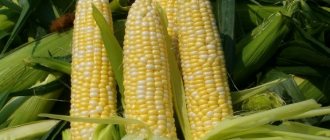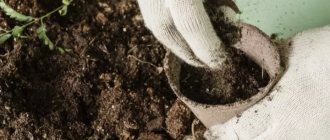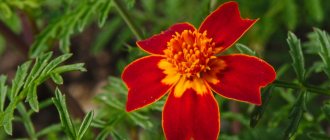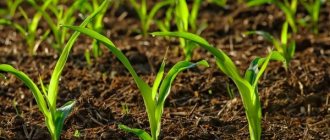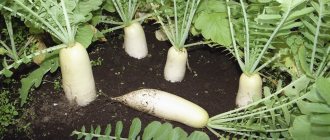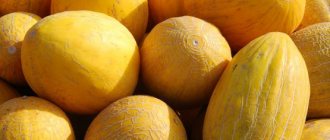Corn cob is a storehouse of useful microelements for the human, animal and poultry body. The culture is in demand in agriculture, but is also suitable as a side dish. And what taste do salads acquire with the addition of sugar grains!
But not everyone knows how to succeed in growing corn, because they forget to plant corn seedlings.
The process of growing a large fruit from a yellow grain does not take much time if you approach it correctly. It remains to clarify the rules for germinating seedlings, and then seedlings.
Necessary conditions for growing corn
@zlot silviu
At the time of sowing, the soil at a depth of 10 cm should warm up to +12 degrees. From germination to waxy ripeness of grains, it takes from 70 days to 4 months. On private plots, people usually cultivate early ripening varieties of corn.
They begin harvesting the cobs by waiting until the top fibers turn brown. At this moment, the yellow grains of the cob will be in milky-waxy ripeness.
- Cobs removed from the stems can be stored at a temperature of +20 degrees for no more than 2 days.
- Products can be stored in the refrigerator for no more than 3 weeks. For long-term use, corn kernels can be frozen or canned.
To form a large vegetative mass and yield, corn spends a lot of nutrition and thereby greatly depletes the soil.
Therefore, after harvesting the crop, it would be wise to apply organic and mineral fertilizers to the site. Breeders have developed corn hybrids that have a short growing season and increased resistance to cold. Thanks to this, the crop can now be successfully grown even in the northern regions of the country. But in these areas it is grown through seedlings.
Selecting a site for planting
The crop is planted only in well-lit areas. It is advisable that the garden bed be closed from the north wind. It is impossible for groundwater to pass close to the site.
If the soil in the garden bed is too heavy and dense, you should add sand or compost when digging. The cereal will grow well in soil with neutral acidity.
Corn will produce very good yields only on fertile soil. Therefore, in the fall, the beds are dug up and covered with superphosphate and humus. Crop rotation should also be taken into account - corn will grow well after peas, beets, beans, potatoes and carrots.
Seedlings on the site are planted in rows with a step of 50 cm. The same distance is left between the plants in the row. After planting, it is necessary to compact the soil around each plant and water it abundantly. It is advisable to mulch the beds with straw or dry grass after planting.
When to plant corn seedlings and in which regions it is worth doing this
@Pingerrain
In regions where spring comes late and summer is short, corn is grown using the seedling method. With this option, the cob harvest ripens 2-3 weeks earlier, before the onset of a steady cold snap.
Seeds for seedlings at home are sown after March 15, which allows seedlings with 3 true leaves to be planted in open ground a month later.
Corn has a long taproot and therefore does not tolerate the transplantation procedure well. The breaking of roots during transplantation greatly inhibits the further development and growth of corn seedlings.
To minimize damage to the roots and the plant stress they cause, it is better to sow seeds for seedlings in peat pots. They are planted in the ground together with pots, avoiding mechanical damage to the roots.
Seedlings can be grown on a windowsill, as well as in a heated film greenhouse or greenhouse. Corn seedlings are moved into open ground when warm weather sets in. The seedlings should be about a month old and have 3 true leaves.
Preparing for sowing
If we are talking about using your own seed, preparations should begin in the fall. To do this, during harvest, well-ripened ears are selected from healthy plants. Then the heads of cabbage are dried in the sun and stored in a dry, ventilated room. 3-4 days before planting corn grains for seedlings, they are taken out again, laid out on the windowsill and subjected to air-thermal heating at room temperature.
Calibration
Next comes a careful inspection of the seeds. This step is relevant even if seeds in store packets are used to germinate maize seedlings. Large grains without dents or spots are considered suitable for planting. It is advisable to choose the same color and size. Seeds that raise doubts should be discarded immediately.
If you plan to grow corn seedlings in large quantities, you can use another method instead of visual inspection. Soaking in salted water will help identify non-viable seeds. After a quarter of an hour, they will float to the surface, and the germinating grains will sink to the bottom.
Etching
After the initial selection, the grains are wrapped in a piece of gauze and placed in a weak solution of potassium permanganate for 20-30 minutes (a fungicide is also suitable). The seeds need such a “bath” so that the future plant remains healthy during the growing season. After the allotted period, the seed must be thoroughly rinsed with clean water.
Germination
This step is not strictly necessary. But since corn grains have a hard shell, before planting seedlings, it is recommended to soak them for germination using one of the following methods:
- Place sawdust in a container and moisten it generously with water from a spray bottle. Seeds are placed on top at a distance of 2-3 cm from each other. Then the container is loosely covered with a lid and left on the windowsill for 2 days.
- Add 2 tbsp to 1 liter of warm water. l. wood ash and leave for 2 days. Then the seed is placed in the resulting solution for 12 hours.
The appearance of small sprouts will indicate that the material is ready for planting.
Soil selection and preparation
For growing corn seedlings, a universal soil mixture for vegetables is suitable, which can be purchased at a specialty store. You can also make a suitable soil yourself. To do this, you will need to mix 3 parts of peat with neutral acidity, 1 part humus and 1 part sand. To improve seedlings, wood ash is added to the resulting substance in a ratio of 1:10.
In order to avoid the risk of infection by viruses and parasites, soil prepared with your own hands must be disinfected. To do this, the soil is calcined in the oven for 20 minutes at a temperature of 70-90 degrees, or you can hold the soil for 2 hours over a steam bath, stirring it from time to time. After thermal exposure, the soil must be shed with a solution of Fitosporin.
It is better to disinfect the soil in advance to give the soil a chance to rest and infuse. Complete restoration of beneficial microflora will occur in 4 weeks. It is better to postpone planting corn seeds for this period. But if waiting is an unaffordable luxury, then sowing work is carried out immediately after watering with the biofungicide Fitosporin.
Containers suitable for planting grains
The root system of corn shoots is quite delicate and fragile, so individual containers are used for growing seedlings. These can be plastic cups, recycled containers, garden cassettes, peat tablets, etc. The main requirements for the container are a diameter of 12-14 cm, a height of 8-10 cm and the presence of drainage holes. Excess moisture will negatively affect the development of the cereal sprout, so if there are no holes at the bottom of the planting container, they should be made.
In addition, corn grains for seedlings can be sown in a “snail” - a special garden cloth made of waterproof material, twisted into a spiral. The width of the strip is 15 cm. Such a container will significantly save space and avoid the need to pick plants.
Planting containers need to be pre-treated against potential fungal infections. This procedure is especially important if the container has already been used last year. To disinfect planting containers, place them in a 9:1 solution of water and household bleach for at least 10 minutes. Then rinse thoroughly with running water. Mineral deposits are removed with a wire brush or scraped off with a knife.
It would be a good idea to carefully inspect the rims, as salts often accumulate in this place. If they are not cleaned, the seedling stems will suffer from dehydration, which will negatively affect the quality of the plant.
Large boxes for planting corn seedlings are used only as a last resort, because in a single space the likelihood of intertwining the root system of young plants increases. Such shoots will most likely die during picking or transplanting into open ground.
When to plant corn in open ground
As noted above, corn has increased requirements for air and soil temperatures, as well as light. Therefore, in the spring it is planted last in open ground.
- Corn seeds will lie in the soil and will not germinate until it warms up to +10 degrees, and the seedlings will stop growing at the slightest cold snap.
- It is not recommended to start planting before the soil warms up to +12 degrees. In most regions of Russia, this moment occurs between May 5 and May 20.
The growing season for early varieties of corn is 70-80 days, and late varieties reach technical ripeness in 110-120 days. This should also be taken into account when determining the timing of sowing seeds for seedlings.
If cold weather or frost is expected, it is recommended to cover the seedlings with film.
Corn seeds can be planted in open ground even in Siberia. But then it is advisable to sow soaked seeds of early varieties, and then there will be no complete confidence that the cobs will have time to ripen before the autumn cold.
@graibeard
The following factors influence the timing of when to plant corn:
- variety - for areas with a short summer period, early varieties are chosen;
- age and health of the seedlings - the older and stronger the seedlings, the sooner the cobs will ripen;
- weather conditions - the sum of positive temperatures for seed germination is 100 degrees, which means that at a temperature of +10 degrees, seedlings will appear on the 10th day.
Depending on the variety
It is best to purchase seeds of varieties zoned in a particular region or varieties bred by local breeders. They will be adapted to the climatic conditions prevailing in the region where the crop is cultivated.
So, for Siberia and the Urals, high-yielding early-ripening hybrids with a growing season of 70 days are suitable and grown through seedlings. When calculating the timing of planting corn, you need to take into account the length of the growing season and plus the 10 days required for seed germination. Here it is worth paying attention to such early hybrids and varieties as:
- The Golden Fleece;
- Dobrynya;
- Gourmand 121;
- Spirit.
Gourmet 121
Dobrynya
In the middle zone, the number of warm summer days is greater and this makes it possible to use mid-season varieties for cultivation with a growing season of 80-90 days and even to harvest seeds from plants for future sowings. The following varieties and hybrids of corn are suitable for this area and the capital region:
- Sundance;
- Early gold 401.
In the Moscow region, you can try to grow a late variety of corn, Ice Nectar, but it will only be able to fully ripen in a favorable year.
Depending on the purpose of cultivation
The timing of corn sowing depends to some extent on the purpose of its use. Seeds of early varieties, intended for immediate consumption, long-term freezing or canning, are sown in late April - early May, when the soil temperature is +12 degrees and frosts have passed. If the weather does not allow you to meet these deadlines, then you need to sow seeds for seedlings in a warm greenhouse or greenhouse at this time.
Observation will help determine the time of harvesting cobs - corn kernels reach milky ripeness approximately 25 days after flowering. This phase lasts no more than a week, and then it passes into the phase of milky-wax ripeness. It is impossible to be late with cleaning, since the delay negatively affects the quality and taste of the product.
It can be calculated that full ripeness of corn grains, depending on growing conditions, occurs 50-55 days after flowering.
In plants whose cobs have reached full ripeness, the stem darkens and the leaves dry out. This serves as a signal to begin harvesting corn for seeds and for technical purposes.
According to the Lunar calendar 2022
A large group of vegetable growers, when determining the timing of sowing corn seeds, adhere to the recommendations of the lunar calendar.
According to the lunar calendar, the following days will be favorable for planting corn in 2022:
| Favorable days | |
| March | 11-13 |
| April | 7-10, 14, 15, 17, 21, 22 |
| May | 1, 2, 7-10, 12-20, 24-25 |
| June | 1-6 |
By planting corn on one of the days indicated above, you can be sure that the work was carried out in the most optimal time.
In 2022, unfavorable days fall on the following dates:
- January – 2, 3, 17, 18
- February – 1, 2, 16, 28
- March – 1, 2, 18, 27, 28
- April – 1, 2, 16, 23
- May – 1, 16, 30
- June -14, 18, 29
- July – 13, 14, 28, 29
- August – 11, 12, 27-28
- September: 9-10, 26, 27
- October: 9, 10, 25, 26
- November: 1, 2, 7-9, 24, 25, 28, 29
- December: 7-9, 23-25
On these days, it is not recommended to plan sowing corn seeds in the soil and planting seedlings of the crop in a permanent place.
Depending on the region
The time for planting corn in open ground occurs when the soil and surrounding air warm up to +12 degrees and, according to the weather forecast, further warming is expected. When to plant corn as seedlings and in open ground:
South of the country. In the southern regions and republics of Russia, such as Crimea, Kuban, Stavropol, the land and air warm up sufficiently already at the beginning of May. There is no need to grow it through seedlings, since the summer is long and the grains on the cobs of even late varieties have time to ripen safely.
Middle zone and Moscow region. Summer is not as warm as in the south, and spring comes later. Therefore, sowing dates should be moved 20 days later than in the south. You can, of course, plant seeds from May 10 to 15, but then you will need to cover the seedlings with film.
Siberia. Corn has time to ripen only to milky-waxy ripeness. Complete ripening of grains is impossible due to the early onset of autumn cooling. Sowing is carried out in well-lit areas at the junction of May and June.
Ural and Far East. It is widely used to grow corn in greenhouses, where narrow strips are allocated for it along the entire perimeter of the building. Sowing seeds in this variant is carried out in early May. If traditional technology for growing crops is used, then sowing seeds in open ground is carried out in late May - early June.
Leningrad region. In this region and other northern regions, corn sowing begins after June 15, and in some years, when spring is late, sowing occurs at the end of June. Cultivation is carried out through seedlings, early cold-resistant varieties are used.
Ukraine. The territory of this country combines 3 climatic zones. Therefore, the timing of sowing corn in them varies. In the steppe zone, corn is planted from April 15 to April 20. In the forest-steppe zone, crop planting is shifted by 1-2 weeks, which corresponds to the end of April. And in the more northern forest zone, there is no rush to plant corn seeds, since the climate there is colder.
Planting of crops there is usually planned for mid-May.
Belarus. In this country, the timing of corn sowing coincides with the timing that is accepted for the forest zone of Ukraine. Sowing seeds in open ground is carried out in the second half of May. At this time, the earth is already warming up quite well, creating favorable conditions for the germination of corn seeds and the growth of seedlings.
Ripening time
Depending on the variety, corn matures 70-150 days after planting. You can tell that the cob is already ripe by its appearance - it becomes plump and bright yellow. You can press down on the grain with your fingernails - a white liquid should come out of it.
In the middle zone, it is better to grow early ripening varieties that are resistant to diseases and low temperatures. As a rule, corn is harvested in August-September. In the northern regions, where corn is grown through seedlings, it is necessary to harvest as early as August in order to reach frost. In the south, corn can be harvested all fall.
Corn has excellent immunity to diseases and insect pest attacks. However, if the rules of care are not followed, plants can become ill with fusarium and root rot. If symptoms of the disease are detected, the plants are sprayed with a fungicide solution, but only in the initial stages of growth. Do not spray ripening corn.
Of the insects, the most dangerous are aphids, against which insecticide spraying is used. During the ripening period, it is recommended to use garlic infusion against aphids.
How to plant corn correctly
In order to ultimately grow a rich harvest of corn, it is necessary to carry out a number of preparatory work in a timely and high-quality manner related to preparing the soil in the area for corn, preparing seed material for planting, and correctly performing the planting process itself.
In the southern regions, corn grows well on loam filled with fertilizers. And in the north, sandy loam soils are allocated for it, which quickly warm up in the spring.
Choosing a place for corn and its preparation
Beds with corn should be located in a bright and well-lit area. Site preparation should begin in the fall; as a last resort, digging of the soil can be done in the spring of the year of planting, approximately 30 days before the intended planting.
The area is dug up with a shovel to a depth of 30 cm with the simultaneous application of organic and mineral fertilizers in the following quantities per square meter:
- potassium sulfate – 20 g;
- superphosphate – 30 g;
- ammonium nitrate – 15 g;
- rotted manure – 3 kg.
After digging, they level it with a rake.
In country houses and gardens, corn is often grown together with other crops, where it acts as a support for climbing plants. This is acceptable, but you should always remember that corn does not tolerate cold northern winds.
Therefore, crop planting can be observed along the fence, which protects the corn from the wind. The best neighbors for corn are cucumbers.
The best predecessors for corn in the garden are the following crops:
- tomatoes;
- beans;
- potato;
- cabbage;
- pumpkin;
- zucchini.
One of the worst precursors for corn is millet, since these crops have the same pests.
Corn grows well on sandy, peaty and loamy soils with an acidity level close to neutral.
Preparing seeds for sowing
@Jimmy Coupe
Even before sowing, any vegetable grower must independently decide in what form to plant the seeds - dry or sprouted. But first of all, you need to calibrate and reject the following seeds:
- damaged;
- infected with diseases;
- deformed;
- small;
- affected by pests.
Thanks to calibration, the germination of seed material significantly increases.
If you plan to germinate corn seeds, you must first solar warm the seeds. Why are they scattered on a piece of tarpaulin or film and kept in the sun for 4 days.
Further preparatory work with seeds is carried out according to the following algorithm:
- the seeds are placed in a pink solution of potassium permanganate for 35 minutes for disinfection;
- remove the seed material from the solution, wash it in running water, and then dry it on a paper towel;
- Place wet gauze folded in 3-4 layers on a plate, place seeds on it and cover with the same layer of wet gauze on top;
- the plate with the seeds is placed in a dark place where the temperature is maintained at +25 degrees for 5 days;
- On the fifth day, sprouts usually appear and immediate planting of seeds in prepared beds is required.
When using dry seeds for planting, only disinfection is carried out with potassium permanganate. After which the seeds are dried and sown in the soil.
Video from Yulia Minyaeva: sowing corn for seedlings in snails
Video: corn seedlings in sawdust
Tatyana, author of the “Harvest Garden” channel, tells how to plant corn seedlings in sawdust.
Sowing seeds in open ground
After the seeds are prepared, you can proceed directly to the sowing procedure itself. Sowing work is carried out in the following sequence:
- loosen the beds on the site so that the soil surface becomes level;
- Make seeding furrows in the garden bed with a depth of 4 to 7 cm. At what distance should I plant corn? – Between rows there should be from 50 to 60 cm;
- Pour plenty of water into the grooves and wait until the water is completely absorbed;
- place the seeds in furrows at intervals of 35 cm;
- Sprinkle soil on top of the groove and lightly compact the soil.
For sowing with dry seeds, a depth of 7 cm is assumed, and when planting with sprouted seeds, it is enough to plant the seeds at a depth of 4 cm.
Video: planting corn seedlings in the ground
Corn care
In order for corn in the open ground to produce full, mature and juicy ears, it will require attention and care. Apart from fertilizing, which we will consider separately, corn does not need much - loosening, watering and removing stepsons. It is these side shoots that form on the stem in the second half of summer that take away the bushes’ strength and reduce the yield. Therefore, as soon as the stepsons on the corn become clearly noticeable (reach a length of 15-20 cm), they must be mercilessly removed by breaking off or cutting off.
Loosening is especially important for corn at the beginning of the season, when it grows slowly and does not absorb nutrients well. It is important to ensure that a crust does not form at the roots, and that weeds do not shade your heat- and light-loving plantings. You can remove weeds either manually or with a hoe, while being careful not to damage the roots of the corn itself.
In principle, corn also grows in the steppes with a long absence of water, but your goal is not to test this crop for survival, but to obtain a harvest, so it is better not to forget about watering. At least once a week, generously moisten the soil under the corn, and during the period of planting and ripening of the ears, reduce the interval between waterings by half.
If your corn's flowering period occurs during wet, cold weather and you think there is not enough pollination, you can increase it yourself. To do this, the sultans (male flowers) are plucked from the tops of the stems and shaken over the cobs (female flowers).
How to feed corn
After planting seedlings or seeds sprouting and the formation of 6 full-fledged leaves on the stems, the corn must be fed. Excellent options are a 5% solution of chicken manure, infused for several days, or a 10% solution of mullein. It is necessary to feed corn with organic matter after abundant watering, so as not to burn the plantings.
A couple of weeks after organic feeding, you need to give the plants additional mineral nutrition. To do this, add 20 g of potassium sulfate or potassium magnesia and superphosphate into the rows. In the first half of July, you can foliar feed corn, giving preference to fertilizers with microelements with the obligatory presence of nitrogen. Urea is well suited for this purpose (dissolve 50 g of fertilizer in 10 liters of water). You need to spray corn in the morning or evening, and to prevent leaf blanching, you can add 30 g of magnesium sulfate to the solution.
Pests and diseases
Corn can be affected by:
- rust;
- rot;
- fusarium;
- mosaic.
In rainy summers, young plantings are sprayed with Fitosporin for prevention, and the seeds are pickled in a solution of potassium permanganate before planting. Sick plants are destroyed.
They parasitize on crops:
- wireworm;
- scoops;
- meadow moths.
For prevention, crop rotation is observed, and traps are laid out for wireworms. It is permissible to use insecticides before flowering.
Getting a second harvest
If you want to get a second harvest in the same area, after harvesting, all the plants are cut off and the seeds of these hybrids are sown in the rows according to the same patterns. It is advisable to sow with swollen seeds followed by watering.
If agricultural technology is followed, harvesting will be in the third ten days of September, which is very economically profitable, since during this period there is no sweet corn at milk maturity, and it can also be frozen with significant energy savings.
Where can I buy
We told you when and how to plant corn. As you can see, by following simple planting and care rules, you can ultimately achieve good yields, regardless of the region where the crop is grown. You don’t need any extra effort for this, you just need to show desire and some diligence.
By spending a small amount of time and labor, you can please your family members with a tasty and healthy product, as well as diversify the diet of your pets. Read this article again and follow the recommendations outlined in it. The result will not take long to arrive.
Victor Immel My entire childhood was spent in nature, which probably predetermined my subsequent choice of profession - to become an agronomist.
Step-by-step instructions for planting corn kernels
The process of growing young shoots of maize seeds is quite simple. To give the crop a good start and get strong seedlings, it is recommended to adhere to the following sequence in sowing work:
- A drainage layer 1-1.5 cm thick is placed at the bottom of the container. These can be either specialized materials, for example: sterilized expanded clay, perlite, etc., or improvised means: pebbles, charcoal, fine broken ceramic tiles, brick chips.
- The seed container is filled with soil mixture. There should be a gap of 1.5 - 2 cm between the edge of the container and the ground.
- For each seed, make a hole 3.5–4 cm deep.
- Corn grain, dry or already sprouted in advance, is placed in the hole and covered with earth.
- The soil is carefully leveled and moistened from a sprayer with warm water +33-35°C.
- Sowing containers are covered with transparent plastic film, a lid or glass to create a greenhouse effect and maintain a microclimate.
- Containers with seedlings are placed in a well-lit, warm place - the range from + 23 to +25 ° C is considered optimal for seed germination. Containers with seedlings can be placed on shelves in the greenhouse, on window sills, or on other elevated surfaces. But you shouldn’t leave it on the ground: it may happen that the roots grow into the drainage holes and are injured during replanting.
As a rule, there is no need for additional watering until the first shoots appear. But regular ventilation will be useful. To do this, it is enough to open the containers for 15-20 minutes every day.
Possible problems and methods for solving them
Corn diseases are easier to prevent than to eliminate them during the growing season. If your corn plant turns yellow and begins to wilt, some of the possible causes could be pests or disease.
Quite often, corn seedlings are affected by fusarium. A pink or white coating appears on the surface of diseased seeds, and if seedlings emerge from them, they turn brown and die. However, some sprouts may not die, but in this case they will lag behind healthy specimens in development and growth, their root system will be weakened, the stem will be very fragile, and the leaf blades will dry out.
If such a bush does not die during the growth process, it will still not produce a harvest. This disease cannot be treated, which is why it is so important not to neglect preventive measures: before sowing, the seed material is treated with a solution of a fungicidal agent.
To prevent and prevent diseases, plants are sprayed with special preparations of biological and chemical origin. To prevent various diseases, it is recommended to treat the seeds immediately before planting.
Modern insecticidal preparations and fungicides will perfectly help cope with the proliferation of pests or with an existing disease.
All threats must be eliminated at an early stage, otherwise the chances of saving even half of the harvest are slim.
Diseases of corn seedlings
If at some stage you disrupt the technique of growing corn seedlings from grains, you can create all the conditions for the appearance of common seedling diseases:
- Fusarium: a fungus that attacks the stem, seedlings and ear. A grayish-ashy coating is detrimental to plants, therefore, it is worth paying serious attention to the pre-sowing treatment of planting material and observing crop rotation.
- Rot of the stem and rhizome: grows intensively throughout the plant and is explained by the creation of too wet conditions (high rainfall, excessive watering, swampy soil). The outcome of the disease is the death of the culture. To solve the problem, the approach must be comprehensive (use of fungicides, crop rotation, limited watering).
- Rust: practically untreatable. The fungus infects the plant and leaves no chance of saving the crop. Usually such seedlings are burned to prevent the spread of the disease.
- Loose smut: widespread. It affects the plant completely, stopping the growth of the plant and destroying most of the crop.
Most diseases lead to irreversible processes, which is why the issue of crop rotation and seed preparation should be taken seriously. It is necessary to plant corn grains only after pre-treatment.
Tips for growing the plant
By following a few tips, a novice gardener can get an elite corn harvest.
- Crop rotation is very important for corn. It will feel better in the soil after potatoes, beets, legumes, winter crops, and buckwheat. The main thing is not to sow corn after millet, as the risk of borer infection is increased.
- An excellent neighbor is melons (watermelons, melons, pumpkins). They prevent the earth from drying out.
The process of planting corn seeds. Photo used as illustration. Source: Yandex.Images
Choosing the best variety
Corn takes about 4 months to grow and ripen.
In the southern regions, it can be planted directly in open ground, and in regions with short summers, the cereal is grown through seedlings. Varieties are selected by zoned ones:
- Suitable varieties of corn for the Moscow region and other regions of the middle zone: Spirit, Sundance, Pioneer, Lakomka, Jubilee, Syngenta, Early Golden, Ice Nectar, Dobrynya.
- Corn varieties for open ground in Siberia and the Urals: Bylina, Jubilee, Khutoryanka, Spirit, Lakomka 121.
If you like some other variety, pay attention to its growing season. Corn is a heat-loving plant, so for regions with short summers you should choose early-ripening varieties.

